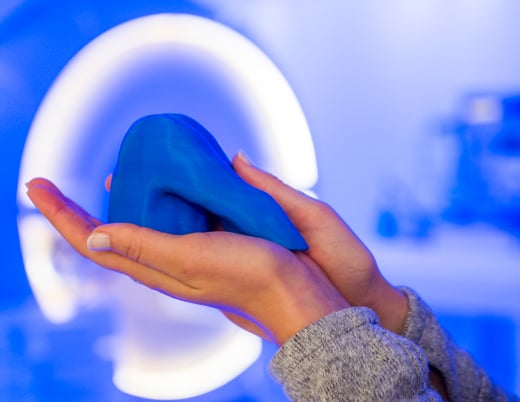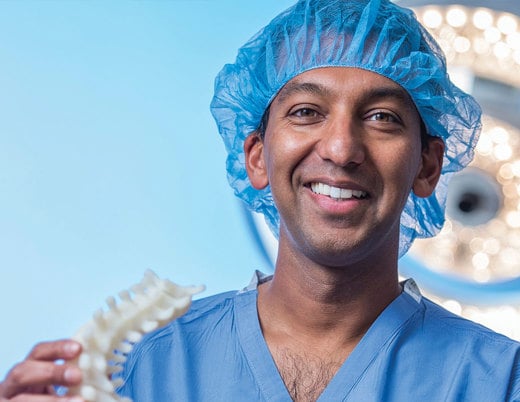Can robot-assisted pediatric spine surgery effectively improve safety and accuracy?
Studies show a return to the operating room for malpositioned screws happens in up to 3% of scoliosis cases (1 - 4). Orthopedic surgeon and pediatric spine specialist Mark Erickson, MD, MMM, is adamant that’s an avoidable complication. So he’s working to improve it by honing the use of a navigation and robotics system called Mazor X. Children’s Colorado is one of only three pediatric hospitals in the country with access to the technology. Robot-assisted spine surgery isn’t new. It’s already used in adults. But those surgeries are largely focused in the lumbar spine, where the robot guides the surgeon in placing a small number of screws over a couple of levels.
In pediatric scoliosis surgery, Dr. Erickson and his team are covering a much larger area with significantly more screws — 12 and 14 levels or 18 to 20 screws. As part of a beta group for Mazor X, they’ve been working to fully understand the machine’s capabilities and limitations so they can improve its safety and accuracy. In fact, the team recently completed its 100th robot-assisted surgery — the most of any pediatric hospital in the country.
How Mazor X works
It takes many steps and numerous layers of verification to ensure a safe and successful robotic surgery. For example, the robot isn’t just attached to the operating table — it’s also attached to the patient’s spine. Correct mounting of the robot to the patient is crucial for stability and accuracy, as is placing navigation instruments at visually known anatomic landmarks and frequently confirming accuracy of the display.
A 3D intraoperative imaging system called an O-arm allows the team to collect anatomical data that they then use to digitally map placement of a screw. Intraoperative imaging gives the team an incredible amount of information including in-depth insight into the anatomy, small pedicle diameter and atypical screw trajectories. It’s information they weren’t getting with traditional fluoroscopic methods.
Once the screw is mapped, the team sends that data to the robotic arm, which moves to the correct vertebral segment. Then, the surgeon places the drill through the robotic arm for accurate screw placement.
A valuable assistant
When it comes time to place the screw, there’s a key nuance. What the robot can’t do is account for the many unforeseen circumstances that occur during pediatric surgery that make a competent surgeon essential.
“You can tell the robot where you want it to go, but as the surgeon, you have to make sure it’s in the spot where you planned it to go,” says Dr. Erickson. “The robot helps an extremely qualified surgeon to perform surgeries even more safely. And with proper supervision, it’s a much safer way for me to ensure and instruct my fellows and residents to acquire surgical precision. Mazor X is more of a co-bot than a robot, as the surgeon must be acutely aware and knowledgeable in order to optimize and harness this remarkable technology.”
Dr. Erickson and two colleagues — orthopedic surgeons Daniel Hedequist, MD, from Boston Children’s Hospital and Noelle Larson, MD, from Mayo Clinic — recently published a manuscript titled “Navigation and Robotics in Pediatric Spine Surgery” in the Journal of the Pediatric Orthopedic Society of North America. The manuscript provides a closer look at how Mazor X works including the value it could add, safety precautions and opportunities for improvements prior to more widespread adoption.
- Diab, M., et al., Neural complications in the surgical treatment of adolescent idiopathic scoliosis. Spine (Phila Pa 1976), 2007. 32(24): p. 2759-63.
- Parker, S.L., et al., Accuracy of free-hand pedicle screws in the thoracic and lumbar spine: analysis of 6816 consecutive screws. Neurosurgery, 2011. 68(1): p. 170-8; discussion 178.
- Hicks, J.M., et al., Complications of pedicle screw fixation in scoliosis surgery: a systematic review. Spine (Phila Pa 1976), 2010. 35(11): p. E465-70.
- Di Silvestre, M., et al., Complications of thoracic pedicle screws in scoliosis treatment. Spine, 2007. 32(15): p. 1655-61.
Featured Researchers

Mark Erickson, MD
Medical Director, Spine Program
The Orthopedics Institute
Children's Hospital Colorado
Professor, fellowship director
Orthopedics
University of Colorado School of Medicine





 720-777-0123
720-777-0123










